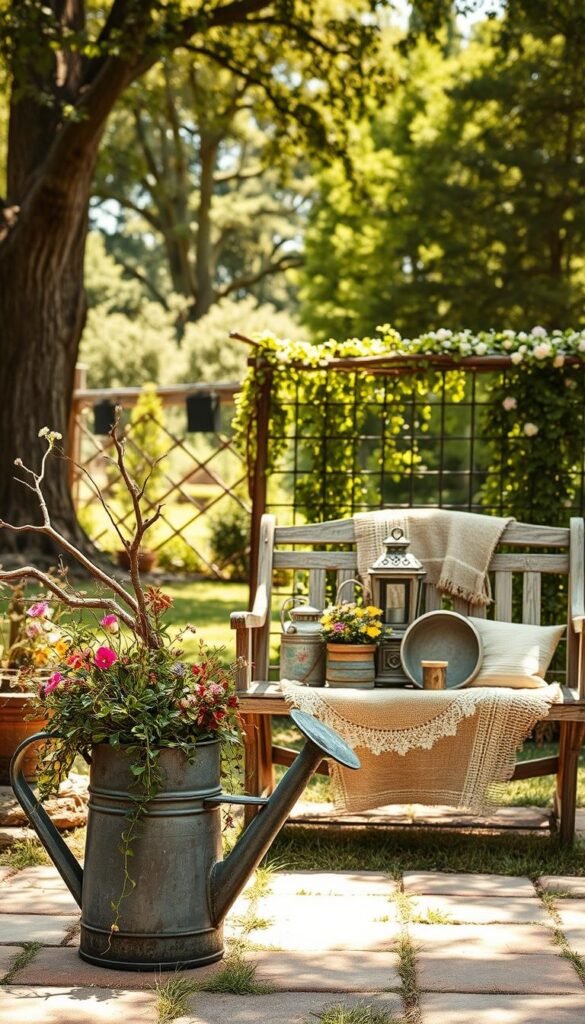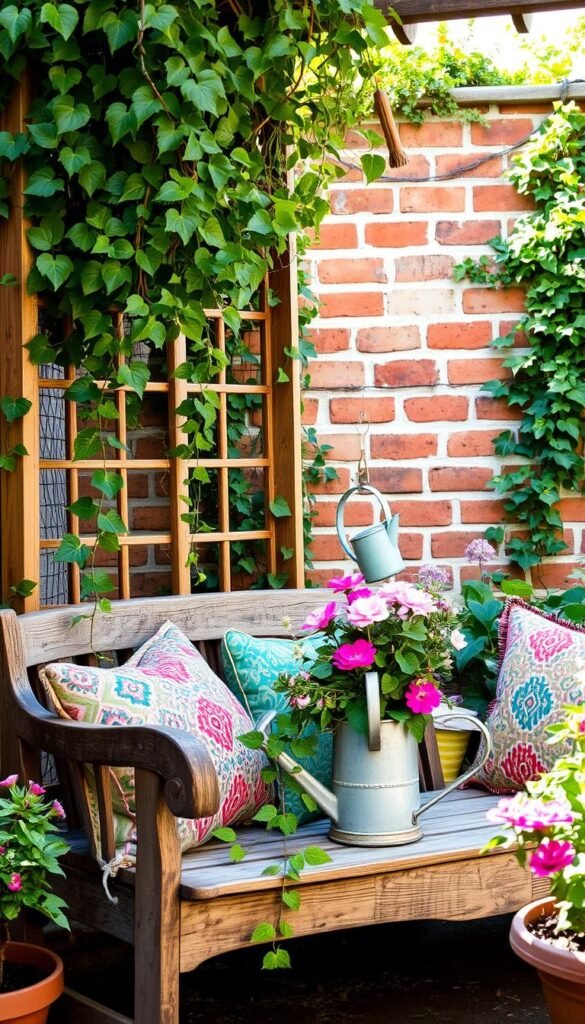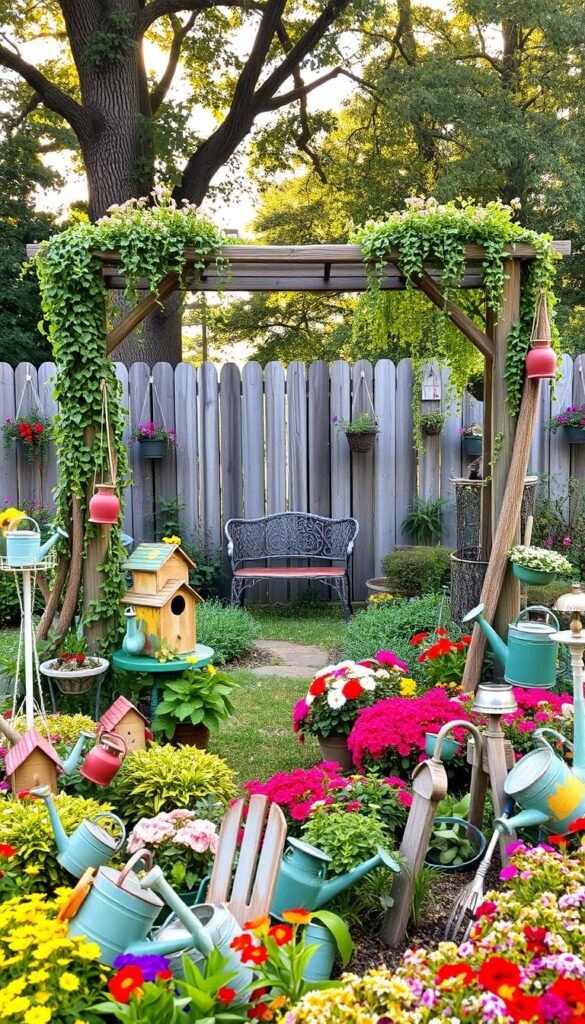What if your next garden project didn’t require a trip to a fancy store? Imagine transforming forgotten items into vibrant plant displays that tell a story. This approach blends creativity with sustainability, letting you craft a unique outdoor space without overspending.
Old bathtubs become whimsical flower beds. Mismatched silverware turns into charming plant markers. Even rusty bed frames can frame climbing vines. The key is pairing these unconventional containers with healthy plants that thrive in their new homes.
You’ll discover how to balance practicality with artistry. Learn simple DIY tricks for drilling drainage holes, choosing soil mixes, and positioning eco-friendly container gardening setups in sunny spots. We’ll explore vertical designs using ladders or gutters to maximize small spaces.
This guide walks through every step – from hunting for treasures at local sales to styling your finished masterpiece. Get ready to create a living collage that reflects your personality while keeping materials out of landfills. Your garden’s about to become the most interesting room in your home.
Getting Started with Your Flea Market Garden

Imagine a garden where every piece has a past life and a green future. This is the heart of junkyard gardens—spaces built using repurposed objects that add character while reducing waste. By blending old items with living plants, you create a dynamic outdoor art installation that evolves with time.
What Makes a Junkyard Garden Unique?
These gardens thrive on creativity, not cash. Think cracked teacups as succulent holders or weathered crates stacked into vertical planters. The goal is to pair unconventional containers with plants that complement their size and style. A vintage colander, for example, becomes a whimsical hanging basket for trailing petunias.
Designing with Purpose
Start by sketching your space. Note where sunlight hits and how large your plants will grow. A rusted wheelbarrow overflowing with marigolds needs room to shine, while mismatched chairs painted in bold hues can frame a cozy seating area. Choose a theme—like “rustic farmhouse” or “industrial chic”—to guide your hunt for materials at local sales.
Remember: balance is key. Too many items create clutter, but a well-placed birdcage planter or repurposed ladder shelf adds visual interest. Check that containers have proper drainage and can withstand your climate. With thoughtful planning, your garden becomes a living scrapbook of stories waiting to bloom.
Transforming Yard Sale Finds into Creative Garden Decor

Your garden could become a gallery of repurposed treasures with just a little imagination. Start by hunting for items with interesting shapes or textures—think cracked pottery, metal buckets, or wooden crates. These pieces add character while giving plants a home that sparks conversation.
Upcycling and Reusing Salvaged Items
Turn a broken concrete pipe into a towering succulent planter or bend whiskey barrel bands into sculptural trellises. Sand rough edges, drill drainage holes, and apply weather-resistant paint to match your style. Old toolboxes become herb containers, while chipped teacups cradle delicate blooms like bright petunias.
Selecting Unique Finds from Flea Markets
Look for items that tell a story. Vintage crocks work as rustic planters, and wire baskets hung vertically create instant living art. Prioritize pieces made of durable materials like copper or cedar—they’ll age beautifully outdoors.
Incorporating Personal Style into Your Garden
Mix bold industrial pieces with soft flowering vines for contrast. Paint a retro dresser in sunset hues to store gardening tools, then top it with trailing ivy. Your space should feel like an extension of your home’s personality—quirky, elegant, or wonderfully eclectic.
Flea Market Gardening: Turning Yard Sale Finds into Garden Treasures

Breathing new life into discarded materials requires equal parts vision and practicality. Let’s explore how to craft durable garden features that marry artistic flair with everyday functionality.
DIY Junk Garden Essentials and Tools
Transform a cracked metal bucket into a self-watering planter in three steps:
- Drill drainage holes in the base using a 1/4-inch bit
- Line the bottom with gravel for improved water flow
- Insert a recycled plastic bottle with pierced holes as a reservoir
Old wooden shutters become vertical herb racks when sanded and sealed with beeswax. For broken tools, remove handles and repurpose metal heads as decorative stakes for climbing plants like morning glories.
Eco-Friendly Art Techniques for Garden Decor
Weather metal pieces naturally by soaking them in vinegar-water solutions for 48 hours. This creates rustic patinas without harsh chemicals. Use these revived materials to build:
- Whimsical wind chimes from silverware
- Mosaic stepping stones using broken ceramic tiles
- Reclaimed wood signs painted with milk-based paints
Protect wooden creations by rubbing them with linseed oil instead of synthetic sealants. For colorful accents, mix natural pigments like turmeric or beet juice into water-based primers.
Practical Tips for Budget-Friendly Garden Makeovers

Revamping your outdoor space doesn’t need deep pockets—just clever thinking. Start by scouting local sales for metal baskets, weathered crates, or chipped ceramics. These items add texture and history when paired with vibrant blooms. One gardener transformed a rusted colander into a hanging planter bursting with Proven Winners petunias, proving even humble finds can shine.
Displaying Salvaged Items with Flair
Create focal points by grouping three similar pieces at varying heights. An old ladder becomes a vertical herb station when topped with tin cans of basil and thyme. For pathways, line cracked teacups along edges as miniature flower beds. Balance bulky items like concrete statues with airy plants like cosmos or lavender to avoid visual clutter.
| Item | Use Case | Pro Tip |
|---|---|---|
| Galvanized buckets | Tomato planters | Drill side holes for airflow |
| Wire baskets | Vertical succulent walls | Line with coconut coir |
| Wooden crates | Modular seating/storage | Seal with natural beeswax |
Mix eras by placing vintage metal planters beside modern resin chairs. Paint faded containers in bold hues to match your flowers, then add solar string lights for evening charm. Rotate displays seasonally—use woven baskets as autumn mum holders or repurpose holiday tins as spring seed starters.
Remember: A single statement piece, like a retro bike filled with pansies, often makes greater impact than cluttered arrangements. Your space should whisper stories, not shout them.
Wrapping Up Your Flea Market Garden Journey
Your outdoor space becomes a living storybook when crafted with imagination and purpose. By blending DIY creativity with eco-friendly practices, you’ve learned to transform overlooked items into thriving plant displays. From drilling drainage holes in salvaged containers to styling vertical herb walls, each step adds personality while reducing waste.
Remember: every cracked teacup or weathered crate holds potential. Revisit our tips on pairing plants with unconventional homes or designing cohesive layouts. Your garden grows richer when you mix textures—like galvanized buckets bursting with flowers beside repurposed wooden shutters.
Share your progress! Post photos of that vintage bicycle planter or thrifted birdbath fountain online. Communities love seeing how thrifting adventures spark fresh ideas. Gardening this way isn’t just about plants—it’s crafting a home filled with stories that bloom season after season.
Keep experimenting. Whether adding solar-lit mason jars or stacking crates for strawberries, your space evolves with every small change. Start today—one quirky planter or upcycled trellis brings you closer to a garden that’s unmistakably yours.






